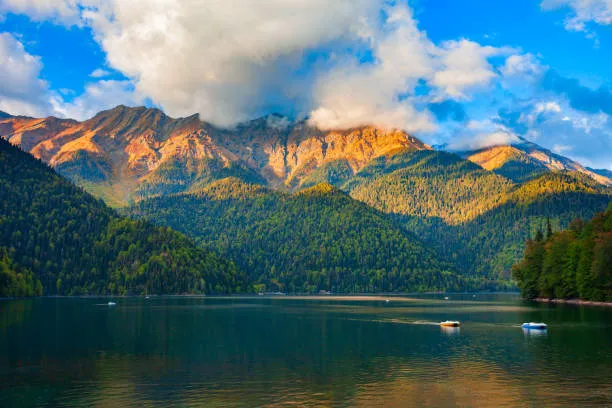General information
Abkhazia lies on the eastern coast of the Black Sea, backed by the Greater Caucasus. Coastlines are humid subtropical, while northern valleys reach alpine meadows and glaciers. The self-name Apsny is often translated as Land of the Soul; the commonly used exonym Abkhazia likely derives from ancient ethnonyms recorded by Greek and Roman authors. De facto authorities style the entity the Republic of Abkhazia, with a presidential system, parliament, and ministries; internationally it is recognized by a handful of states and considered by Georgia to be its Autonomous Republic. Population estimates hover around 240-250 thousand. Official languages under de facto authorities are Abkhaz and Russian; Russian is widely used in daily life, and Armenian and Mingrelian are also heard. Currency is the Russian ruble. Time zone is UTC+3. High offices include a de facto president and prime minister; security structures include the Abkhazian armed forces with close integration and treaties with Russia. Gambling is not a significant legal sector and dedicated casinos are not a feature of mainstream tourism. Telecommunications are provided by local operators; internet quality varies beyond major towns.
History
Human presence in Abkhazia dates to the Paleolithic. In antiquity, the coastal city of Dioscurias (near present-day Sukhumi) became a Greek trading hub linking the Black Sea and Caucasus. The region interacted with Mithridatic, Roman, and Byzantine spheres; Christianity spread early, leaving basilicas and monasteries. Through the early medieval period, local principalities were connected to western Georgian polities. Between the 8th and 10th centuries, the Kingdom of Abkhazia rose as a powerful Caucasian state before dynastic union helped form the Kingdom of Georgia. Centuries of shifting influence followed, including Georgian, Byzantine, and later Ottoman pressures on the coast and highlands. The Russian Empire incorporated Abkhazia in the 19th century after the Caucasian War; depopulation and migrations reshaped its demography.
After the 1917 revolutions, Abkhazia’s status shifted in the Georgian Democratic Republic and then the Soviet system. In 1931, it became the Abkhaz ASSR within the Georgian SSR. The Soviet era developed resorts like Gagra and Pitsunda, citrus and tea plantations, viticulture, and research institutions; it also imposed complex demographic engineering and Russification policies alongside Georgianization trends.
As the USSR unraveled, competing national projects hardened. War broke out in 1992-1993 between Georgian government forces and Abkhaz formations supported by North Caucasian volunteers and Russian elements. The conflict was devastating: significant loss of life, destruction of infrastructure, and mass displacement, particularly of ethnic Georgians from Abkhazia. A fragile ceasefire left Abkhazia outside Tbilisi’s control, with Russian peacekeepers and international observers present for years. In August 2008, amid the Russia-Georgia war centered in South Ossetia, Abkhaz forces took the remaining Georgian-held Kodori Gorge, and Russia recognized Abkhazia’s independence; a few other states later followed. The line of contact along the Enguri River became a de facto boundary.
Since then, Abkhazia has operated with its own institutions, heavily dependent on Russia for security, budget support, and trade. Reconstruction advanced unevenly: coastal resorts revived for Russian holidaymakers, while interior towns still display damage and abandonment. Returns of displaced persons have been partial and contested, especially in the Gali district. Political life features leadership turnovers, protests over governance and economy, and continued debates about sovereignty, identity, and language. The region remains unrecognized by most of the world and central to Georgia’s territorial integrity claims.
Industry
Tourism and agriculture are the main pillars. Agriculture centers on citrus, tea, nuts, subtropical fruits, beekeeping, and small-scale viticulture. Light food processing and construction materials exist, but heavy industry is limited; many Soviet-era factories never fully recovered. The area is not a birthplace of global consumer brands, though the Gagripsh restaurant building is a regional icon and Veryovkina and Krubera caves are global superlatives in speleology. The trade structure is oriented toward Russia, including fuel, building materials, and consumer goods.
Flora and fauna
Coastal Colchic forests transition to beech, fir, and spruce, then subalpine and alpine belts. Endemics include Colchic boxwood stands and rare plants adapted to humid gorges. Wildlife features brown bears in remote ranges, chamois, wild boar, wolves, and diverse raptors. Conservation areas protect Lake Ritsa environs and karst massifs. Box blight has severely damaged native boxwood. Some species are listed in regional Red Data books, and collectors should avoid harvesting plants, reptiles, or corals. Export of wild flora and fauna without permits is prohibited; travelers should not purchase wild animal products.
Religion and ethnic groups
The population is majority Orthodox Christian, with Muslim communities and adherents of Abkhaz traditional religion; there is also an Armenian Apostolic presence. Abkhaz, Armenians, Russians, and Mingrelians are the main ethnic groups. Religious practice often blends church observance with clan and shrine traditions. Social life emphasizes hospitality, elders’ authority, and ritual toasts with wine or chacha.
Wars and conflicts
The 1992-1993 war and 2008 hostilities define recent memory. The Enguri line is militarized; sporadic incidents occur, though large-scale fighting has not resumed. War cemeteries and memorials are present in major towns. The region has experienced assassinations and blasts at times in the postwar period, largely localized. Visitors should avoid discussing politics intensely and respect local sensitivities about the conflict and displacement.
Quality of life
Quality of life varies widely: seaside districts are livelier during season; mountain villages can be under-served. Informal economy and patronage networks are significant. Transparency and governance challenges persist. Prices are generally lower than in major Russian resorts, but imported goods can be costly.
Healthcare
Medical facilities are basic compared to Western standards. For serious conditions, evacuation to larger Russian cities is common. Tourists should carry necessary medication, a first-aid kit, and travel insurance that clearly covers this territory. Pharmacies exist in towns with limited schedules off-season; brand availability is inconsistent.
Sports
Football is the most followed sport; local clubs compete in regional leagues. Wrestling, judo, boxing, and weightlifting are popular. International representation follows the region’s political status, with occasional participation in alternative sports federations.
Holidays
Public and traditional observances include New Year (1 January), Orthodox Christmas (7 January), Victory and Independence Day (30 September, marking 1993), as well as clan and village shrine festivals. Likhnashta in Lykhny combines ritual, horsemanship, and feasting. Dates of religious feasts follow the Orthodox calendar.
Traditions
Hospitality is a social code: guests are seated and fed generously, toasts are led by a tamada. Respect for elders and family lineages is pronounced. Tourists should dress modestly in churches and monasteries, ask before photographing people, and avoid loud behavior in villages at night.
Interesting facts
Veryovkina Cave in Abkhazia is the deepest known cave on Earth. The Reprua is among the shortest rivers in the world. Soviet leaders frequented Pitsunda and Gagra resorts. New Athos Cave has a tourist railway inside. Abkhaz toasting culture is elaborate and symbolic. Abandoned sanatoria and rail facilities create striking urban exploration vistas alongside restored promenades.
Money
Currency is the Russian ruble. Cash dominates outside central seaside zones. ATMs exist in Sukhumi, Gagra, Pitsunda, and Gudauta but can be unreliable; carry backup cash. Cards are accepted in some hotels and restaurants, less so in small cafes and markets. Exchange services are oriented to rubles; foreign cash exchange options are limited, and the best rates are typically near busy coastal towns. Tipping is appreciated but not mandatory: 5-10 percent in restaurants for good service is customary. Always count change; small denominations help.
Everyday details
Electricity is 220V, 50Hz, with Europlug types C and F. Mobile operators include A-Mobile and Aquafon; roaming can be expensive and coverage weak in mountains. Public smoking restrictions are looser than in the EU but expect no-smoking areas in some indoor venues. Internet speeds vary; seasonality affects reliability.
Clothing
Coastal towns are casual: summer wear, sandals, hats, and light layers. Mountain trips require waterproof shells and warm layers even in July. In monasteries and churches, cover shoulders and knees; headscarves are customary for women in some shrines. Beach attire is fine on the shore but not in village centers.
Tourism
Plan at least 4-6 full days to see Sukhumi, New Athos, Lake Ritsa, Gagra, Pitsunda, and a mountain gorge. Add days for hiking to alpine lakes or caving excursions with licensed guides. Summer brings warm seas and crowded beaches; spring and early autumn balance weather and space. Expect a mix of renovated waterfronts, Soviet-era hotels, guesthouses, and family-run apatskha eateries. English is limited; Russian is the lingua franca. Organized excursions are easy to arrange locally; self-driving opens mountain valleys, but road conditions and signage require care.
Types of tourism
Beach and resort stays on the Black Sea; cultural and pilgrimage trips to monasteries; nature and hiking in alpine belts; speleology at show caves and guided expeditions; gastronomic and wine visits to rural apatskha; photography of landscapes and heritage sites.
Tourist attractions
– Sukhumi Botanical Garden – historic garden with thousands of species and shaded avenues
– Lake Ritsa – emerald mountain lake surrounded by firs and cliffs
– New Athos Cave – vast karst system with underground halls and a tourist rail
– New Athos Monastery – late 19th century Orthodox complex below Iverian Mountain
– Gagra seaside promenade – palm-lined waterfront and resort heritage buildings
– Pitsunda Cape and pine grove – beaches and aromatic Pitsunda pine forest
– Veryovkina and Krubera cave areas – record-breaking karst massifs for expert cavers
– Iverian Mountain ruins – fortifications above New Athos with coastal views
– Besleti Bridge – medieval stone arch near Sukhumi
– Gega (Gegsky) Waterfall – dramatic cascade in a high valley
Non-tourist attractions
– Tkvarcheli industrial remnants – former coal town with abandoned infrastructure
– Ruined piers and sanatoria – post-Soviet decay contrasting with refurbished zones
– Kodori access roads – sensitive interior routes not recommended for tourists
– Outlying collective farm sites – snapshots of rural post-collective life
Local cuisine
Abysta (cornmeal porridge) anchors meals, paired with sulguni cheese, beans, or meat. Achashv is a boat-shaped cheese bread; achma is a layered cheese pastry. Satsivi-style walnut sauces, adjika chili paste, smoked meats, river fish, herb-laced salads, and seasonal mandarins are staples. Homemade wines and chacha frame toasts. Lunch runs mid-afternoon; dinner is unhurried. Tipping 5-10 percent is polite where service is attentive. Drink boiled or bottled water in the interior; choose busy eateries for fresher fare.
Why visit
To see glaciers above citrus groves, monasteries above sea caves, and a culture where toasts, mountain lore, and Black Sea languor meet. Abkhazia offers stark beauty, affordability, and a sense of elsewhere.
Tourist safety
Petty theft is sporadic; use standard precautions. Avoid restricted and militarized zones and any mine-marked areas. Road risks include speeding and livestock on lanes. In the backcountry, beware unstable cliffs and sudden weather. Stray dogs appear near markets. Infectious disease risks are typical of the region; practice food and water hygiene. Local attitudes are hospitable, but political debates can be sensitive. Common emergency numbers are 01 fire, 02 police, 03 ambulance; from mobile, 112 may route to emergency services depending on operator.
Tourist infrastructure
Service quality ranges from simple guesthouses to renovated seaside hotels; staff typically speak Russian, with limited English. Restaurants vary from rustic apatskha to modern gastropubs in Sukhumi and Gagra. Tours are commonly arranged in Russian; private guides can customize nature trips.
Entry rules
Entry and exit procedures are unusual. International practice and Georgian law conflict: Georgia considers entry legal only from its controlled crossings; the de facto side typically allows entry from Russia. Requirements, permits, and practical feasibility can change; travelers must verify their legal exposure with their home country and insurers, and ensure that their Russian visa status (if transiting Russia) permits return. Do not carry items with overt political symbols. Customs rules restrict weapons, narcotics, and cultural property exports.
Transport
Within Abkhazia, marshrutka minibuses connect towns by day; schedules thin late. Taxis are common; agree on price in advance. Private drivers handle mountain routes. Intercity trains may run seasonally along the coast. Ride-hailing apps are limited. Tickets are bought on board or at kiosks in Russian.
Driving
Car hire is limited; most visitors use private drivers or arrive by car from Russia. Drive defensively: variable asphalt, potholes, livestock, and narrow mountain passes. Police checkpoints are routine; keep documents handy. No formal toll roads. Zero tolerance for drunk driving; random checks occur. Urban parking is informal; seaside zones can charge. Winter tires and chains are advisable in highlands. Dashcams are common. Carry your national license plus an international permit. A higher-clearance vehicle is recommended for mountain valleys.
Noise rules
Quiet is expected late evening to morning in residential areas. In villages, avoid loud music after 22:00.
Daily budget
Shoestring: 2500-4000 RUB per day for dorms/guestrooms, street food, minibuses
Mid-range: 5000-9000 RUB for private room, sit-down meals, taxis, a paid excursion
Comfort: 10000-18000 RUB for boutique seafront hotels and private tours
Approximate USD at 1 USD ≈ 95 RUB: about 26-42 USD, 53-95 USD, 105-190 USD respectively.
What not to do
Do not enter restricted military or border zones. Do not fly drones without checking local rules and sensitive sites. Avoid political symbols or slogans that may offend. Do not remove artifacts, plants, or animals. Dress modestly in religious sites and ask before photographing people.
Climate
Coastal areas have humid subtropical weather: hot summers, mild winters with rain; mountains see cool summers and snowy winters. Sea is warmest July-September. Best times for balanced weather and thinner crowds are May-June and September-October. Spring brings blooms; autumn foliage is vivid around Ritsa.
Traveler tips
Carry cash in small notes and your passport at all times. Pre-download offline maps and basic Russian phrases. Book mountain guides for serious hikes or caves. Bring plug adapters, sunscreen for the coast, insect repellent for forests, and a rain shell for the mountains. Keep receipts for accommodations and transport; take photos of car condition if hiring a driver for multi-day trips.
- Mtsyri: tracing Lermontov in Mtskheta
- And in Africa the mountains are this high
- Evacuation of Kyiv icons takes fight for Ukraine’s heritage to Louvre in Paris
- Gibraltar
- Moscow
- Namibia sees almost double-digit growth
- Uluṟu-Kata Tjuṯa and Kakadu National Parks Etched in Time
- Nanai
- Africa
- Bali
- Brazil Travel Costs
- Film about Kamchatka – Volcanoes, Wildlife and Untouched Nature
- Tourist places where Hemingway went
- Namaqualand Flower Route
- How to follow Donald Trump’s travel trail
- Luo
- 24 Facts About The Colosseum
- Great lakes
- Georgia
- Istanbulkart Scams: What Tourists Should Watch Out For












